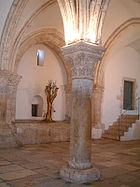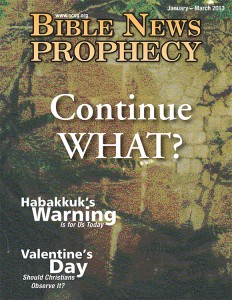Church of Rome trying to make a Jerusalem ‘Cenacle’ deal that could align with prophecy

Interior of Modern Cenacle, Jerusalem
A reader sent the following:
An historic agreement has been drafted between Israel and the Vatican. The Israeli authorities have granted the Pope an official seat in the room where the Last Supper is believed to have taken place, on Mount Zion in Jerusalem, and where David and Solomon, Jewish kings of Judea, are considered by some researchers, to also be buried…
According to our sources, the agreement, which is expected to be ratified next June, gives the Pope a “special authority” over the second floor of the building, so that Christian pilgrims will be able to celebrate religious functions like Pope John Paul did in 2000.
The agreement constitutes Israel’s capitulation to the Vatican’s efforts to “Christianize” the holy site, like when a Catholic convent was built in Auschwitz.
The Catholic Church has long wanted control over part of the area on Mt. Zion so as to turn it into an international religious center for Catholics. The blueprint of the agreement reads as follows: “The Vatican hands over this use of the Cenacle to the Custody of the Holy Land which will keep the Cenacle open from 6 AM to 8 AM for the celebration of the Holy Mass”. http://www.israelnationalnews.com/Articles/Article.aspx/12814#.USKyVfL-uSq
The upper room there is in the building known as the “Cenacle.”
Certain Catholics and some others consider that it is the “Mother Church” (http://www.zenit.org/en/articles/jerusalem-patriarch-s-holy-thursday-homily).
The Cenacle is believed to have been the site of perhaps the earliest real Christian church building. Some legends suggest this is near or where the last Passover of Jesus, Pentecost of Acts 2, and/or certain other notable New Testament events took place (like Matthias being chosen as an apostle, Acts 1:12-26). However, while its New Testament use is scientifically questionable (and not highly likely), it certainly was a location that the Nazarene Christians(these would have practices much more like the Church of God as opposed to Church of Rome) used until they were forced out of it in the fourth century by supporters of Emperor Constantine’s professed faith. Although the Greco-Romans have built their type of church around it, some few of the original bricks continue. You can see the some of the original cenacle building bricks by looking at the front cover of the Jan-March 2013 edition of Bible News Prophecy magazine:
The original bricks constitute a type of “temple” in the sense that this seems to have been the closest thing to a physical church building (and actually more closely resembled a synagogue) where real Christians attended for services.
Several years ago, on November 26, 2008, in a paper submitted to evangelists in my former association, I wrote that the Cenacle was a possible building for the man of sin to sit in:
If a Jewish temple is not being discussed in 2 Thessalonians 2:4, then where might the “man of sin” sit?
… if Revelation 11:1-2 allows for it (which it may not, see further below), there is an ancient building, usually now referred to as the Cenacle (the word is a derivative of the Latin word “cena,” which means dinner), that may be the possible location. It is believed to have been used by the original Christians in Jerusalem until the Greco-Romans took it through with Imperial support in the fourth century.
Michael P. Germano wrote:
In Jerusalem, just outside the Zion Gate of the Old City near the crest of Mount Sion, lie the partial remains of an ancient synagogue consisting of a niche, walls, floors, and foundations, incorporated into a dilapidated building…
Do these ancient ruins belong to the first-century Judeo-Christian synagogue seen by Roman emperor Hadrian on his grand progress? Are these the remnants of the building on Mt. Sion…called the Church of the Apostles and the Holy Church of God? These are the traditions…tradition suggests this is also the site of the Upper Room where Jesus of Nazareth observed his last Passover with his followers and where his disciples resided following his Crucifixion awaiting the Day of Pentecost…
The Cenacle
In this work its identity and title is simply “the ancient synagogue” or the Ancient Church of the Apostles. In the fourth and fifth centuries, however, orthodox…referred to the building in a variety of ways.
For Eusebius it was the “Holy Church of God” (Eusebius, Proof of the Gospel 6.18; Ferrar 1920b:30-31). Cyril said it was the “Upper Church of the Apostles” (Cyril of Jerusalem, Catechetical Lectures 16.4; Schaff and Wace 1989a:116). Egeria often referred to it as “On Sion” (Wilkinson 1971:294). Epiphanius, alluding to it in its second century context, said when Hadrian visited Aelia Capitolina it was a small “Church of God” (Epiphanius, De Mensuris 14; Koester 1989:93). Theodosius said it was “Holy Sion which is the Mother of all Churches” (Wilkinson 1977:66)…
On July 30, 381, following the First Council of Constantinople, emperor Theodosius I issued an edict authorizing the seizure of the properties of all non-orthodox churches. This resulted in the ancient synagogue, then in possession of Judeo-Christians, passing into Greco-Roman Christian control. The surrender was made to the orthodox bishops. (The Ancient Church of the Apostles. Copyright © 2002 by Michael P. Germano, pp. 1-4).
Even though the original Christians who used that location for nearly four centuries held to what are most often known as Judeo-Christian (as opposed to Greco-Roman) practices, there have been reports that the Catholics of Rome would like to expand their presence and basically takeover the Cenacle (Owen R. Vatican offers swap deal to regain site of Last Supper. The Times, October 13, 2005)…
Thus, it may be that what was possibly the first and original church building location of the original apostles could appear to be a potential location of the “temple of God”.
Yet, because of Revelation 11:1-2 (discussed below) and the persecution of Christians during the Great Tribulation (Revelation 12:17), I am much more inclined to believe that a building more recently used by the faithful Christians would be better used for political purposes by “the man of sin”, than the ancient one in Jerusalem.
On the other hand, as the Bible shows plans for Jerusalem apparently for eternity (cf. Revelation 21:2-3), perhaps it may be that the ancient location of where the apostles themselves (who became part of “the temple of God”) may possibly be what God had in mind when He inspired Paul’s writings.
But irrespective of which building is referred to in 2 Thessalonians 2:4, it would not seem to be possible for it to be a Jewish, non-Christian, temple in Jerusalem.
The idea of Jerusalem being the “mother church” partially comes from the following scripture:
26 But Jerusalem which is above is free, which is the mother of us all. (Galatians 4:26, KJV)
We in the Continuing Church of God understand that scripture is referring to a spiritual situation, and not a building. However, the wall of the building now called the Cenacle is still of interest and perhaps could have prophetic ramifications.
A scripture, written by the Apostle Paul, that should be of related interest would be the following commendation to a Gentile church for following the spiritual practices that those in Judea had:
13 For this cause also thank we God without ceasing, because, when ye received the word of God which ye heard of us, ye received it not as the word of men, but as it is in truth, the word of God, which effectually worketh also in you that believe. 14 For ye, brethren, became followers of the churches of God which in Judaea are in Christ Jesus (1 Thessalonians 2:13-14, KJV).
And the spiritual practices that the churches of God in Judea (which included Jerusalem) had were those that modern theologians tend to consider to be Jewish or Judeo-Christian.
Sadly, those practices were lost in Jerusalem by the Greco-Romans after the takeover in 135 A.D. under Emperor Hadrian. But the more faithful later returned, and until the time of Constantine often met in the location of the building now called the Cenacle.
But after they were forced out, changes were made. And between the changes, the Crusades, and other events, other than one wall, what stands at the location of the Cenacle is not an actual Church of God building, but it is possible that God could possibly consider that the area is sufficiently related to the temple that it could possibly fulfill 2 Thessalonians 2:4. We will see.
The fact that the Church of Rome now has permission for the Pope (and others) to have a seat there suggests there is a chance the man of sin (the beast of Revelation 13 and King of the North of Daniel 11) might.
Some articles of possibly related interest may include:
The History of Early Christianity Are you aware that what most people believe is not what truly happened to the true Christian church? Do you know where the early church was based? Do you know what were the doctrines of the early church? Is your faith really based upon the truth or compromise?
What Do Roman Catholic Scholars Actually Teach About Early Church History? Although most believe that the Roman Catholic Church history teaches an unbroken line of succession of bishops beginning with Peter, with stories about most of them, Roman Catholic scholars know the truth of this matter. This eye-opening article is a must-read for any who really wants to know what Roman Catholic history actually admits about the early church.
Nazarene Christianity: Were the Original Christians Nazarenes? Should Christians be Nazarenes today? What were the practices of the Nazarenes.
Location of the Early Church: Another Look at Ephesus, Smyrna, and Rome What actually happened to the primitive Church? And did the Bible tell about this in advance?
Which Is Faithful: The Roman Catholic Church or the Continuing Church of God? Do you know that both groups shared a lot of the earliest teachings? Do you know which church changed? Do you know which group is most faithful to the teachings of the apostolic church? Which group best represents true Christianity? This documented article answers those questions.
Apostolic Succession What really happened? Did structure and beliefs change? Are many of the widely-held current understandings of this even possible? Did you know that Catholic scholars really do not believe that several of the claimed “apostolic sees” of the Orthodox have apostolic succession–despite the fact that the current pontiff himself seems to wish to ignore this view? Is there actually a true church that has ties to any of the apostles that is not part of the Catholic or Orthodox churches? Read this article if you truly are interested in the truth on this matter!
Early Church History: Who Were the Two Major Groups Professed Christ in the Second and Third Centuries? Did you know that many in the second and third centuries felt that there were two major, and separate, professing Christian groups in the second century, but that those in the majority churches tend to now blend the groups together and claim “saints” from both? “Saints” that condemn some of their current beliefs. Who are the two groups?
 |
Tweet |
|
